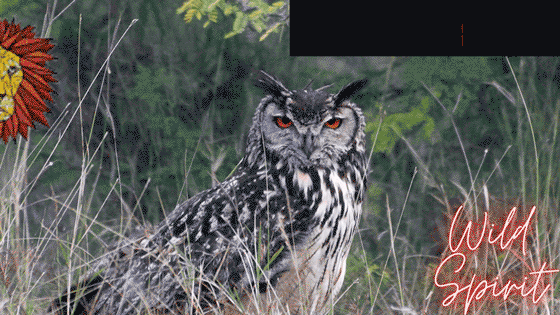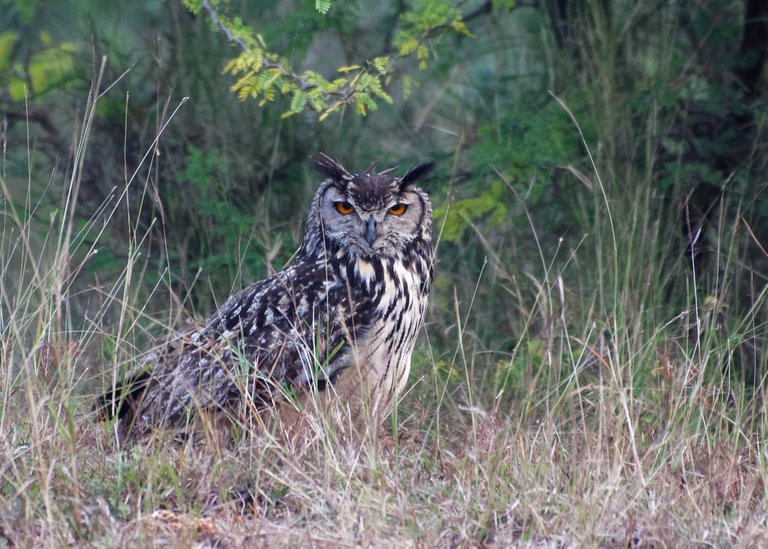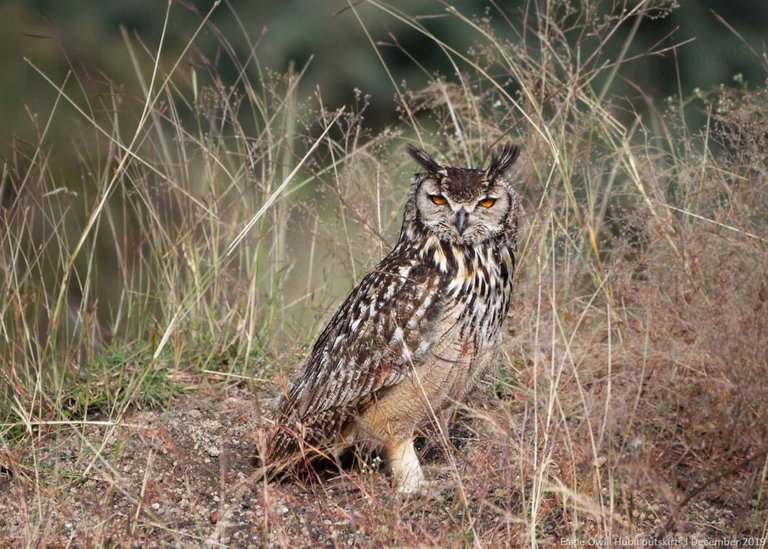Whoooo goes there... Rock eagle owl : My DAILY wildlife photo, species info and musings
“Almost nothing need be said when you have eyes.” ― Tarjei Vesaas
Especially with eyes like the Rock Eagle owl (Bubo bengalensis), nothing needs to be said.
Have you ever been intimidated by only a set of eyes? I have looked into a tiger's eye (Through my lens of course!! I wouldn't have been alive to tell this story otherwise. 😀). I felt a bit of a sense of majesty, a bit of fear but I did not get a feeling that I was getting intensely stared upon and intimidated!
The rock eagle owl though, managed to give me that feeling!

The intense Stare!
I was out with my camera gear on a peaceful Sunday morning. It was not a jungle or any dangerous place by any stretch of imagination. I was only a little outside the town - at a place where typically human habitation dwindles down and fields start cropping up (literally! )
From previous visits to the place, I knew that there was a chance of spotting a jungle cat or a fox in the vicinity. Therefore, I was scanning the bushes ahead of me through my lens.
I started getting a weird feeling that someone was watching me. I can not explain it. I knew there was no one around me because a human would have been visible to me. All the same, I turned and trained my lens on the short grassy patch behind me.
The grassy patch was illuminated by a nice warm ray of sun and as I moved my lens to scan around, I looked right into these ORANGE blazing eyes of a Rock Eagle owl. I almost jumped back a step (mentally) but held my lens steady and watched this wonder sitting on ground!
WHOOOOO it hooted, looking straight at me. Challenging me for being on it's territory! I have usually been confronted by shy birds which fly away in haste when they see any humans approaching. This one was totally different..
Here is the photograph in original size and form:

The Guradian!!
I could not find out if it was protective of it's fledglings or something. It was aggressive for sure.
I tried waiting it out to see if it would fly away and sit on a tree but nope. It continued to sit and stare. It also watched all other sides as if on guard duty. So much so that I took a series of images and created the gif above.
After about a wait of 30-40 minutes, I decided to crawl a bit towards it and see what it does. That got it to move but with a short flight, it just went and sat on another nearby grass patch. I got a very lovely shot though...

A new POSE...
I was not lucky enough to get any closer that day but ultimately, I did get a very close up shot, about a month or two later of the same bird - That is a story for another day!
Information about the bird
Name: Rock Eagle owl
Scientific name: Bubo bengalensis
Size: Around 60 cm (24 inches)
Conservation status: Least Concern (IUCN 3.1)
Description (based on e-bird, Wikipedia and my observations): Rock Eagle owl is primarily known so because, though it inhabits srub to light or medium forrests, it is mostly found in rocky regions. It is a large bird but very silent in flight. Typically it's diet consists of rodents but it also goes for small birds and chicks of doves, partridges and other birds. Birds like the crow, drongos and even sunbirds sometimes, are seen to be mobbing it in an attempt to drive it away since it eats their chicks at night.
Information about photograph
- Aperture: F5.6
- ISO: 640
- Shutter: 1/800
- Support: Handheld shot
- Camera: Nikon D500
- Lens: Nikkor 200-500mm
- Image format: Photo clicked in RAW and edited for presentation sizing
A big thank you for support
Thanks to c/hive-106444 (Feathered friends community) for providing this wonderful opportunity to present my experience and photographs. Thanks to @barbara-orenya and @melinda010100 for all the support and encouragement to this community. Special thanks to @nelinoeva also for starting the Species hunt initiative. My posts are not exactly in that format but have all the necessary info and Good original Photos. Further guidance will be very much welcome.
Thanks to HIVE for this wonderful platform. I am using the Hive logo in the post collage for showing that the image and post is a dedicated HIVE post. Hope that is OK. The animated HIVE logo is a graphic created by @doze and free to use as per his post. Many thanks to @doze.
Note: All images and collages in this blog are created by me, based on photos clicked by me personally and/or free vector images from Pixabay
Quotes used, if not credited, are either from unknown authors or are proverbial old sayings.




Your content has been voted as a part of Encouragement program. Keep up the good work!
Use Ecency daily to boost your growth on platform!
Support Ecency
Vote for new Proposal
Delegate HP and earn more
@ecency Thank you. Much appreciated
Great photos and wonderful information about this magnificent bird!
Thank you so much. It’s great to get appreciation from the founder of the community.
Beautiful portrait of this owl.
Thank you so much
Oh my god, what an encounter!
I am a bit jelous, as I have never seen an owl in the wild. Magnificent.
When I read about the tiger, got chills, was it in the wild too?
I have been lucky to get some close ups of owls. Will share in my posts. I don’t know how much people are interested in just wildlife pics and writing about them but I will keep posting daily. Thanks for your constant interest and encouragement.
The tiger encounter was in a buffer zone of a wildlife reserve forest. Will write about that one too one of these days
I am looking forward to your future posts. 🙂
It will be interesting to read about the tiger too. My only encounter with tiger was in the zoo and I am having mixed feelings about zoos.
😊. Sure. Will keep posting
I don’t like to see caged animals. I am, therefore, biased against zoos. I do realise that zoos serve the purpose or letting children and genral population become aware of wildlife diversity but I do not like to see freedom of those poor animals curtailed for that.
Reserve forests are much better in this regard.